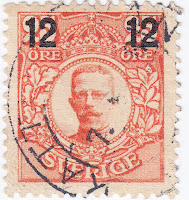These sets are called the 'Landstormfrimärker' or Territorial Defence Stamps.
We're talking about the middle of the First World War.
The surcharge on the stamps were in aid of the Clothing Fund for Territorial Defence Forces.
The first set consist out of 10 stamps, a simple overprint of +5 or +10 öre.
I don't have those stamps myself, but to make this topic more 'complete' I have added a pic of a stamp from this series:
The second series are the most expensive ones.
The surcharge here is with two numerals in stead of one.
Most stamps in this set have no centred overprints. For well-centered copies, prices should be trippled!
Unfortunatly I don't have this set myself, so I added a 'found' picture too.
In this set, also the 5 Kronor 'posthuset' stamp was surcharged, so this set has 11 stamps.
The last set of Landstorm-stamps, is in fact a re-entry of the first set, but with an additional surcharge.
The first stamp from set one is a 5 öre on 2 öre stamp. The first stamp from the third set has this additional surcharge of 7 + 3 öre.
The stamp of originally 2 öre now became : 7+3 öre on 5 on 2 öre.
The first 5 stamps all got surcharged with 7+3 öre, the next 5 stamps got a 12+8 öre overprint.
There exist stamps where the overprint of the last 5 was put on the first 5 and the other way around.
As this set is the least expensive of the three, I managed to get it complete.
The set looks marvellous, but I think, some of the cancells are just CTO.
This set can be found in SCOTT : B 022 - B 031



















































